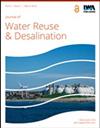蒸汽活化木屑处理重金属和酚类污染废水的效率
IF 2.3
Q2 Environmental Science
引用次数: 4
摘要
本研究包括利用松木屑制备的新型吸附剂吸附模拟工业废水中的重金属和苯酚。进行批量试验以评估这些吸附剂对昂贵的商业吸附剂的可能替代的活性。评估最大吸附容量,并将其与吸附剂的物理化学特性联系起来。吸附剂的最大单层吸附容量(qmax)对应于吸附剂的比表面积。具有较大比表面积的吸附剂显示出较高的qmax估计值(苯酚吸附是一个例外)。蒸汽活化锯末(SAS)对苯酚污染物的吸附量最高为10.0mg/g。SAS在去除Pb和Zn方面的性能与商业活性炭不相上下。金属去除的平衡数据与Freundlich吸附等温线一致,而苯酚去除则满足Langmuir吸附等温线模型。动力学数据被拟合到Lagergren伪一阶、伪二阶和颗粒内扩散模型。因此,确定并讨论了每个动力学模型的动力学参数、速率常数、平衡吸附容量和相关的相关系数。结果表明,Cr的吸附遵循伪二级动力学,表明测试吸附剂的化学吸附,因此颗粒内扩散不是控制Cr吸附整个过程的唯一步骤。在本研究结束时,估计了SAS吸附剂的生产成本(每公斤52美元),并与工业部门的商用AC吸附剂的成本进行了比较,工业部门的AC吸附剂根据工厂的大小和位置有很大的变化(每公斤80-300美元)。本研究的结果可用于设计合适的生态控制程序,以减轻工业废水的有害影响。本文章由计算机程序翻译,如有差异,请以英文原文为准。
Steam-activated sawdust efficiency in treating wastewater contaminated by heavy metals and phenolic compounds
This research study encompasses the utilization of new adsorbents fabricated from pine sawdust for the adsorption of heavy metals and phenol from simulated industrial wastewater. Batch trials are conducted to evaluate the activity of these adsorbents for a possible substitution of the costly commercial adsorbents. The maximum adsorption capacities are evaluated and linked to the physicochemical characteristics of the adsorbents. The maximum monolayer adsorption capacity (qmax) of the adsorbents corresponds to the specific surface area of the adsorbents. The adsorbents with the larger specific surface area have shown higher qmax estimates (phenol adsorption is an exception). The highest amount of the phenol pollutant adsorbed by steam-activated sawdust (SAS) is 10.0 mg/g. The performance of SAS is found to be of the same order as the commercial activated carbon for the removal of Pb and Zn. Equilibrium data for the metal removal are in concordance with the Freundlich adsorption isotherm, whereas the phenol elimination has satisfied the Langmuir adsorption isotherm model. Kinetic data are fitted to Lagergren pseudo-first-order, pseudo-second-order, and the intraparticle diffusion models. Thus, kinetic parameters, rate constants, equilibrium adsorption capacities, and related correlation coefficients for each kinetic model are determined and discussed. The results suggest that the adsorption of Cr follows pseudo-second-order kinetics, indicating chemisorption for the tested adsorbents such that the intraparticle diffusion is not the only step that controls the overall process for Cr adsorption. At the end of this study, the production cost of the SAS adsorbent is estimated ($52 per kg) and compared to the cost of the commercial AC adsorbent in the industrial sector which has a great variation ($80–300 per kg) based on size and location plant. The results of this study can be used for the design of a suitable ecological control procedure to mitigate the harmful effects of industrial wastewater.
求助全文
通过发布文献求助,成功后即可免费获取论文全文。
去求助
来源期刊

Journal of Water Reuse and Desalination
ENGINEERING, ENVIRONMENTAL-WATER RESOURCES
CiteScore
4.30
自引率
0.00%
发文量
23
审稿时长
16 weeks
期刊介绍:
Journal of Water Reuse and Desalination publishes refereed review articles, theoretical and experimental research papers, new findings and issues of unplanned and planned reuse. The journal welcomes contributions from developing and developed countries.
 求助内容:
求助内容: 应助结果提醒方式:
应助结果提醒方式:


